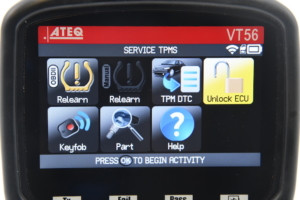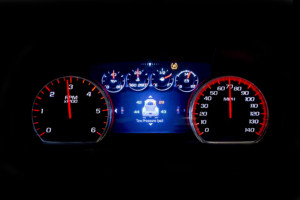Resetting your tire pressure sensor on a 2012 Toyota Camry is a straightforward process, and at millertoyota.net, we want to ensure you have all the information you need to do it correctly. Whether you’ve just changed a tire, rotated them, or are dealing with a persistent warning light, knowing how to reset your TPMS can save you time and a trip to the service center. Explore millertoyota.net for more maintenance tips, service options, and the latest Toyota offers.
1. Understanding the Tire Pressure Monitoring System (TPMS) in Your 2012 Toyota Camry
The Tire Pressure Monitoring System (TPMS) is a critical safety feature in your 2012 Toyota Camry, designed to alert you when tire pressure is significantly low. Why is this important? Because proper tire inflation is essential for:
- Safety: Underinflated tires can lead to blowouts, especially at high speeds.
- Fuel Efficiency: Low tire pressure increases rolling resistance, reducing your gas mileage. Studies have shown that for every 1 PSI drop in tire pressure, fuel economy decreases by 0.3%.
- Tire Life: Driving on underinflated tires causes them to wear out more quickly and unevenly.
- Handling: Correct tire pressure ensures optimal handling and braking performance.
According to the National Highway Traffic Safety Administration (NHTSA), TPMS has significantly reduced accidents related to tire underinflation.
1.1. Direct vs. Indirect TPMS
Before diving into the reset procedure, it’s crucial to understand the type of TPMS your 2012 Camry uses. There are two main types:
- Direct TPMS: This system uses sensors inside each tire to directly measure tire pressure. These sensors transmit data to the vehicle’s computer. If a tire is low, the system alerts you, often indicating which tire is affected. The 2012 Toyota Camry uses a direct TPMS.
- Indirect TPMS: This system doesn’t use physical sensors inside the tires. Instead, it relies on the vehicle’s Anti-lock Braking System (ABS) to monitor tire rotation speeds. If a tire is low, it will rotate at a different speed than the others, triggering the TPMS warning light.
1.2. Identifying a TPMS Issue
The most obvious sign of a TPMS issue is the illuminated warning light on your dashboard. However, the light can indicate different problems:
- Solid TPMS Light: This usually means one or more of your tires are underinflated.
- Flashing TPMS Light: This typically indicates a malfunction in the TPMS system itself, such as a faulty sensor or a problem with the system’s computer.
1.3. Common Causes for TPMS Light Activation
Several factors can cause your TPMS light to turn on:
- Natural Pressure Loss: Tires naturally lose pressure over time, especially with temperature changes.
- Leaks: A puncture, damaged valve stem, or poor seal between the tire and rim can cause a leak.
- Sensor Failure: TPMS sensors have batteries that eventually die. They can also be damaged by impacts or improper installation.
- Recent Tire Service: After a tire rotation or replacement, the TPMS may need to be reset.
2. Step-by-Step Guide: How to Reset Your 2012 Toyota Camry TPMS
Resetting the TPMS on your 2012 Toyota Camry can often be done yourself. Here’s a detailed guide:
2.1. Preparation
- Ensure Tires are Properly Inflated: Use a reliable tire pressure gauge to check the pressure in all tires, including the spare if your Camry has one. Inflate them to the recommended pressure listed on the sticker inside your driver’s side doorjamb.
- Gather Necessary Tools: You might need a tire pressure gauge and an OBDII scan tool, depending on the reset method.
- Park Your Vehicle: Park your Camry on a level surface.
2.2. Resetting the TPMS (OBD Relearn Procedure)
Since the 2012 Toyota Camry uses a direct TPMS, an OBD relearn procedure is required. This involves using a TPMS tool to communicate with the sensors and the vehicle’s ECU (Electronic Control Unit).
- Activate TPMS Sensors: Use a TPMS tool to activate each sensor. Hold the tool against the tire sidewall, near the valve stem, starting with the left front tire. Follow the tool’s instructions to activate the sensor and record its ID.
 Toyota unlock ECU
Toyota unlock ECU
- Repeat for All Tires: Repeat the activation process for the right front, right rear, and left rear tires (and the spare tire, if equipped).
- Connect OBDII Module: Plug the OBDII module of your TPMS tool into the DLC (Data Link Connector) port, usually located under the dashboard on the driver’s side.
- Turn Ignition On: Turn the ignition to the “ON” position, but do not start the engine.
- Transfer Sensor Data: Follow the instructions on your TPMS tool to transfer the sensor data to the vehicle’s ECU. This usually involves pressing an “OK” or “Enter” button on the tool.
- Disconnect OBDII Module: Once the data transfer is complete, disconnect the OBDII module from the DLC.
- Turn Ignition Off and On: Turn the ignition off, then back on.
- Drive Your Camry: Drive your Camry for at least 5 minutes at speeds above 12 mph. This allows the system to fully register the sensor data.
2.3. Using a TPMS Reset Button (If Equipped)
Some Toyota models have a TPMS reset button, but the 2012 Camry typically requires the OBD relearn procedure. If your Camry happens to have a reset button (check your owner’s manual for the exact location), here’s how to use it:
- Inflate Tires: Ensure all tires are properly inflated.
- Locate the Reset Button: The button is often located under the steering wheel or in the glove box.
- Turn Ignition On: Turn the ignition to the “ON” position, but do not start the engine.
- Press and Hold the Reset Button: Press and hold the TPMS reset button until the TPMS light on the dashboard blinks a few times.
- Drive Your Camry: Drive for several minutes to allow the system to recalibrate.
2.4. What to Do If the TPMS Light Stays On
If the TPMS light remains on after attempting the reset procedure, consider these troubleshooting steps:
- Double-Check Tire Pressure: Ensure all tires are still properly inflated. Temperature changes can affect tire pressure.
- Inspect for Leaks: Check your tires for punctures, valve stem damage, or any signs of leaks.
- Check TPMS Sensors: If you have a TPMS tool, use it to check the status of each sensor. A dead or malfunctioning sensor will need to be replaced.
- Consult a Professional: If you’re unable to resolve the issue, it’s best to take your Camry to a trusted mechanic or a Toyota dealer like millertoyota.net. They have specialized tools and expertise to diagnose and repair TPMS problems.
3. Choosing the Right TPMS Sensor for Your 2012 Toyota Camry
If you need to replace a TPMS sensor, it’s essential to choose the correct one for your 2012 Toyota Camry. Using the wrong sensor can lead to compatibility issues and system malfunctions.
3.1. OEM vs. Aftermarket Sensors
You have two main options when it comes to TPMS sensors:
- Original Equipment Manufacturer (OEM) Sensors: These are the same sensors that came with your Camry from the factory. They are guaranteed to be compatible and function correctly.
- Aftermarket Sensors: These are sensors made by third-party manufacturers. They can be less expensive than OEM sensors, but it’s crucial to choose a reputable brand and ensure compatibility with your vehicle.
3.2. Sensor Frequency and Part Numbers
The 2012 Toyota Camry uses a TPMS sensor with a frequency of 315MHz. Here are some relevant OEM part numbers:
- Low Line System: 42067-06020
- High Line System: 42067-06030
It’s always best to verify the correct part number with your Toyota dealer or a trusted parts supplier.
3.3. Programming TPMS Sensors
Some aftermarket TPMS sensors are programmable, meaning they can be configured to work with your specific vehicle. This requires a special programming tool. Other sensors are pre-programmed for specific makes and models.
3.4. Professional Installation
Installing TPMS sensors requires specialized tools and knowledge. It’s generally recommended to have them installed by a qualified technician. Improper installation can damage the sensor or the wheel.
4. Understanding High Line vs. Low Line TPMS Systems in 2012 Toyota Camry
The 2012 Toyota Camry can be equipped with either a low line or high line TPMS system. Understanding the difference is crucial for proper maintenance and troubleshooting.
4.1. Low Line TPMS System
- Indicator: A low line system only uses the standard TPMS warning light on the dashboard to indicate low tire pressure.
- Information: It doesn’t display individual tire pressures. You need to use a tire pressure gauge to check each tire manually.
- Alert Threshold: The TPMS light typically activates when a tire is underinflated by 25% or more.
4.2. High Line TPMS System
- Indicator: A high line system displays the individual tire pressure for each tire on the dashboard or instrument display.
 Modern light car mileage (dashboard, milage) isolated on a black background. New display of a modern car. Tire pressure – TSI.
Modern light car mileage (dashboard, milage) isolated on a black background. New display of a modern car. Tire pressure – TSI.
- Information: This allows you to quickly identify which tire is low and by how much.
- Sensor Location: Some high line systems can also indicate the location of a sensor malfunction in real-time.
4.3. Identifying Your System Type
The easiest way to determine which type of TPMS your 2012 Camry has is to check the instrument display. If you see individual tire pressures displayed, you have a high line system. If you only see the TPMS warning light, you have a low line system.
4.4. Implications for Sensor Replacement
When replacing TPMS sensors, it’s crucial to use the correct type for your system. Installing a low line sensor in a high line system (or vice versa) can lead to inaccurate readings or system malfunctions.
5. Troubleshooting Common TPMS Issues on Your 2012 Toyota Camry
Even with a properly functioning TPMS, you might encounter occasional issues. Here are some common problems and how to address them:
5.1. TPMS Light Turns On and Off Intermittently
This can be caused by fluctuations in tire pressure due to temperature changes. As the temperature drops, tire pressure decreases, potentially triggering the TPMS light. When the temperature rises, the pressure increases, and the light may turn off.
- Solution: Check your tire pressure regularly, especially during significant temperature changes. Inflate your tires to the recommended pressure when they are cold (before driving).
5.2. TPMS Light Stays On After Inflating Tires
If the TPMS light remains on even after you’ve inflated your tires to the correct pressure, try the following:
- Drive Your Camry: Sometimes, the TPMS needs a few minutes of driving to recalibrate.
- Reset the TPMS: Follow the reset procedure outlined earlier in this article.
- Check for Leaks: Inspect your tires for slow leaks that might be causing a gradual pressure loss.
5.3. TPMS Light Flashes Continuously
A flashing TPMS light usually indicates a system malfunction. This could be due to:
-
Dead TPMS Sensor Battery: TPMS sensors have batteries that typically last for 5-10 years. When the battery dies, the sensor needs to be replaced.
-
Faulty TPMS Sensor: The sensor itself might be damaged or malfunctioning.
-
System Issue: There could be a problem with the TPMS module or wiring.
-
Solution: Have your TPMS system diagnosed by a qualified technician. They can use a scan tool to identify the specific problem and recommend the appropriate repair.
5.4. TPMS Light Comes On After Tire Rotation
After a tire rotation, the TPMS might not recognize the new positions of the sensors.
- Solution: Perform the TPMS reset procedure to relearn the sensor positions.
5.5. TPMS Light Comes On After Replacing Tires
When new tires are installed, the TPMS sensors need to be transferred to the new wheels. If the sensors are not properly installed or are damaged during the process, the TPMS light may come on.
- Solution: Ensure that the TPMS sensors were properly installed when the new tires were mounted. If necessary, have the sensors inspected and replaced.
6. Maintaining Your 2012 Toyota Camry TPMS for Optimal Performance
Proper maintenance is key to ensuring your TPMS functions reliably.
6.1. Regular Tire Pressure Checks
Check your tire pressure at least once a month, and more frequently during significant temperature changes. Use a reliable tire pressure gauge.
6.2. Visual Inspections
Inspect your tires regularly for signs of damage, such as punctures, cuts, or bulges. Also, check the valve stems for cracks or leaks.
6.3. Professional Service
Have your TPMS system inspected by a qualified technician during routine maintenance visits. They can check the condition of the sensors and ensure the system is functioning properly.
6.4. TPMS Sensor Replacement
TPMS sensors have a limited lifespan. Replace them as recommended by your mechanic or when the battery dies.
6.5. Proper Tire Inflation
Always inflate your tires to the recommended pressure listed on the sticker inside your driver’s side doorjamb. Avoid overinflating or underinflating your tires.
7. Benefits of a Properly Functioning TPMS
A properly functioning TPMS offers numerous benefits:
- Enhanced Safety: It helps prevent accidents caused by underinflated tires.
- Improved Fuel Efficiency: It ensures optimal tire pressure, which reduces rolling resistance and improves gas mileage.
- Extended Tire Life: It promotes even tire wear, extending the life of your tires.
- Optimal Handling: It ensures proper handling and braking performance.
- Early Warning System: It alerts you to potential tire problems before they become serious.
8. Understanding TPMS DTC Codes for Your 2012 Toyota Camry
When diagnosing TPMS issues, technicians often use diagnostic trouble codes (DTCs) to pinpoint the problem. Here are some common TPMS DTCs for Toyota vehicles:
| Code | Description |
|---|---|
| C2111/11 | Transmitter ID1 Operation Stop |
| C2112/12 | Transmitter ID2 Operation Stop |
| C2113/13 | Transmitter ID3 Operation Stop |
| C2114/14 | Transmitter ID4 Operation Stop |
| C2115/15 | Transmitter ID5 Operation Stop |
| C2121/21 | No Signal from Transmitter ID1 in Main Mode |
| C2122/22 | No Signal from Transmitter ID2 in Main Mode |
| C2123/23 | No Signal from Transmitter ID3 in Main Mode |
| C2124/24 | No Signal from Transmitter ID4 in Main Mode |
| C2125/25 | No Signal from Transmitter ID5 in Main Mode |
| C2126/26 | Transmitter ID Not Received In Main Mode |
| C2127/27 | Transmitter ID Not Received In 2nd Mode |
| C2131/31 | No Signal from Transmitter ID1 in 2nd Mode |
| C2132/32 | No Signal from Transmitter ID2 in 2nd Mode |
| C2133/33 | No Signal from Transmitter ID3 in 2nd Mode |
| C2134/34 | No Signal from Transmitter ID4 in 2nd Mode |
| C2135/35 | No Signal from Transmitter ID5 in 2nd Mode |
| C2141/41 | Transmitter ID1 Error |
| C2142/42 | Transmitter ID2 Error |
| C2143/43 | Transmitter ID3 Error |
| C2144/44 | Transmitter ID4 Error |
| C2145/45 | Transmitter ID5 Error |
| C2165/65 | Abnormal Temperature inside ID1 Tire |
| C2166/66 | Abnormal Temperature inside ID2 Tire |
| C2167/67 | Abnormal Temperature inside ID3 Tire |
| C2168/68 | Abnormal Temperature inside ID4 Tire |
| C2169/69 | Abnormal Temperature inside ID5 Tire |
| C2171/71 | Transmitter ID Not Registered In Main Mode |
| C2172/72 | Transmitter ID Not Registered In 2nd Mode |
| C2173/73 | VSS (Vehicle Speed Sensor) Or ESS (Engine Speed Sensor) Signal Malfunction |
| C2174/74 | Vehicle Speed Signal Malfunction |
| C2176/76 | Receiver Error |
| C2177/77 | Initialization Not Complete |
| C2178/78 | Battery Voltage Malfunction |
| C2179/79 | Tire Pressure Monitor ECU Communication Stop |
| C2181/81 | Transmitter ID1 Not Received (Test Mode) |
| C2182/82 | Transmitter ID2 Not Received (Test Mode DTC) |
| C2183/83 | Transmitter ID3 Not Received (Test Mode DTC) |
| C2184/84 | Transmitter ID4 Not Received (Test Mode DTC) |
| C2185/85 | Transmitter ID5 Not Received (Test Mode DTC) |
| C2191/91 | Vehicle Speed Signal Error (Test Mode DTC) |
| C2192/92 | Select Switch Error (Test Mode DTC) |
| C2194/94 | Engine Speed Signal Circuit Malfunction (Test Mode DTC) |
| C2195/95 | Multi-receiver Antenna Circuit (Test Mode DTC) |
These codes can help technicians diagnose issues such as sensor failures, communication problems, and system malfunctions.
9. Why Choose Miller Toyota for Your TPMS Needs in Boise, Idaho?
When it comes to TPMS service and repair for your 2012 Toyota Camry in the Boise area, Miller Toyota is your trusted partner.
9.1. Expert Technicians
Our certified technicians have extensive experience working with Toyota TPMS systems. They have the knowledge and expertise to accurately diagnose and repair any TPMS issue.
9.2. State-of-the-Art Equipment
We use the latest diagnostic tools and equipment to ensure precise and efficient TPMS service.
9.3. Genuine Toyota Parts
We use only genuine Toyota TPMS sensors and parts, ensuring optimal performance and reliability.
9.4. Competitive Pricing
We offer competitive pricing on all TPMS services, providing you with exceptional value.
9.5. Convenient Service Scheduling
We make it easy to schedule your TPMS service online or by phone.
9.6. Customer Satisfaction
At Miller Toyota, customer satisfaction is our top priority. We are committed to providing you with a positive and hassle-free service experience.
10. Frequently Asked Questions (FAQ) About TPMS on a 2012 Toyota Camry
10.1. How often should I check my tire pressure?
It’s recommended to check your tire pressure at least once a month and before any long trips.
10.2. What is the recommended tire pressure for my 2012 Toyota Camry?
The recommended tire pressure is listed on the sticker inside your driver’s side doorjamb.
10.3. Can I drive with the TPMS light on?
It’s not recommended to drive with the TPMS light on, as it indicates a potential tire problem that could compromise your safety.
10.4. How long do TPMS sensors last?
TPMS sensors typically last for 5-10 years.
10.5. Can I replace TPMS sensors myself?
While it’s possible to replace TPMS sensors yourself, it’s generally recommended to have them installed by a qualified technician.
10.6. Do I need to reset the TPMS after a tire rotation?
Yes, you usually need to reset the TPMS after a tire rotation.
10.7. Will a spare tire with a TPMS sensor activate the TPMS light?
Yes, if your spare tire has a TPMS sensor and is not properly inflated, it can activate the TPMS light.
10.8. What is the difference between a direct and indirect TPMS?
A direct TPMS uses sensors inside each tire to directly measure tire pressure, while an indirect TPMS uses the vehicle’s ABS system to monitor tire rotation speeds.
10.9. Can temperature changes affect tire pressure?
Yes, temperature changes can significantly affect tire pressure. For every 10-degree Fahrenheit change in temperature, tire pressure changes by about 1 PSI.
10.10. Where can I get my TPMS system serviced in Boise, Idaho?
Miller Toyota in Boise, Idaho, offers expert TPMS service and repair.
Maintaining your 2012 Toyota Camry’s TPMS is crucial for safety, fuel efficiency, and tire life. By understanding how the system works, how to reset it, and how to troubleshoot common issues, you can keep your Camry running smoothly and safely. And remember, for all your Toyota service needs in Boise, Idaho, trust the experts at millertoyota.net. Visit our website today to schedule your service appointment or learn more about our services.
Ready to ensure your 2012 Toyota Camry’s TPMS is functioning perfectly? Visit millertoyota.net today! Browse our new and used Toyota inventory, schedule a service appointment, or contact our friendly staff for expert advice. Drive safely and confidently with Miller Toyota!
Address: 208 N Maple Grove Rd, Boise, ID 83704, United States
Phone: +1 (208) 376-8888
Website: millertoyota.net

